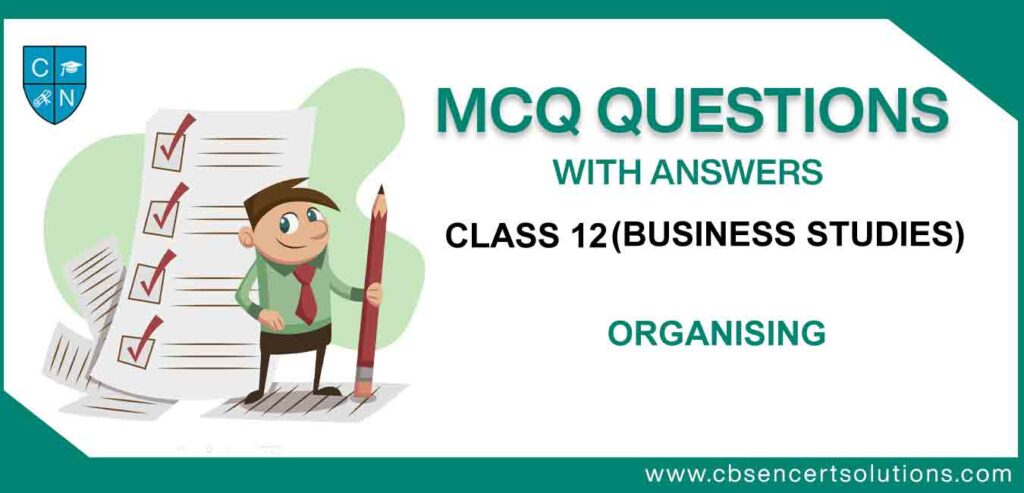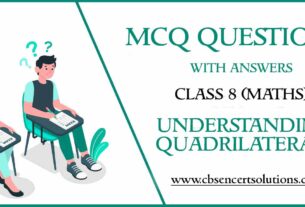Organising Class 12 MCQ Questions with Answers has been gathered for students to rehearse. Students can prepare these Organising MCQ Class 12 Questions with Answers. Each question has four choices with answers. Firstly, Solve all these Questions and check your answer with the right answer. If your answers do not match with the right answer, Don’t worry try again because You need to prepare daily to score higher marks in the Class 12 Business Exam.
Check the below NCERT MCQ Class 12 Business Studies Chapter 5 Organising with Answers available with PDF free download. MCQ Questions for Class 12 Business Studies with Answers were prepared based on the latest syllabus and examination pattern issued by CBSE, NCERT and KVS. Our teachers have provided below Organising Class 12 Business Studies MCQs Questions with answers which will help students to revise and get more marks in exams
Organising Class 12 MCQ Questions of Business Studies
Refer below for MCQ Class 12 Business Studies Chapter 5 Organising with solutions. Solve questions and compare with the answers provided below
Question. Number of sub-ordinates under a superior is called:
(a) Office environment
(b) Strict control
(c) Span of management
(d) Scalar chain
Answer
C
Question. Under what function of management the relationship between different posts (positions) is explained?
(a) Planning
(b) Communication
(c) Organisation
(d) Supervision
Answer
C
Question. Which of the following has a wider scope?
(a) Management
(b) Centralisation
(c) Decentralisation
(d) Delegation
Answer
A
Question. Which organisation structure is consciously or deliberately established?
(a) Formal
(b) Informal
(c) Both (a) and (b)
(d) None
Answer
A
Question. What is the key to managerial post?
(a) Responsibility
(b) Authority
(c) Accountability
(d) None
Answer
B
Question. Which organisation resists changes?
(a) Formal
(b) Informal
(c) Both (a) and (b)
(d) None
Answer
B
Question. Which organisation structure is based on rules and procedures?
(a) Informal
(b) Formal
(c) Both (a) and (b)
(d) None
Answer
B
Question. ‘More delegation of authority helps managerial development’ out of the following with which this statement is related to?
(a) Delegation
(b) Decentralisation
(c) Centralisation
(d) All the above
Answer
B
Question. Which organisation structure does not have duplication of work?
(a) Formal
(b) Informal
(c) Both (a) and (b)
(d) None of these
Answer
A
Question. What is the basis of delegation of authority?
(a) Centralisation
(b) Decentralisation
(c) Both (a) and (b)
(d) Division of labour
Answer
D
Question. Which is not a feature of formal organisation:
(a) It is personal
(b) It is more stable
(c) It is deliberately created
(d) It is based on rules and procedures
Answer
A
Question. Which one is not correct in respect of delegation of authority:
(a) Increase in administrative work
(b) Development of sub-ordinates
(c) Convenience in business expansion
(d) Quick and better decision possible
Answer
A
Question. Which of the following is not the disadvantage of formal organisation?
(a) Lack of initiative
(b) Delay in work
(c) Lack of favourtism
(d) Mechanical relationship
Answer
C
Question. In which organisation structure do we find “group norms”?
(a) Formal
(b) Informal
(c) Both (a) and (b)
(d) None of these
Answer
B
Question. What is decentralisation?
(a) Short form of delegation
(b) Extended form of delegation
(c) Middle form of delegation
(d) None of these
Answer
B
Question. Which of the following organisations lasts longer?
(a) Formal
(b) Divisional
(c) Both the above
(d) Informal
Answer
C
Question. ________ is more stable organisation.
(a) Formal
(b) Informal
(c) Both (a) and (b)
(d) None
Answer
A
Question. Which one of the following is not a part of process of organisation:
(a) Grouping of activities
(b) Doing complete centralisation
(c) Defining inter-relationship
(d) Knowing the objectives of enterprise
Answer
B
Question. Where lies the need of organisation?
(a) In business organisation
(b) In non-business organisation
(c) In both (a) and (b)
(d) No where
Answer
C
Question. How many standardised forms of organisation structure are there?
(a) Two
(b) Three
(c) Four
(d) No definite number
Answer
D
Question. Which of the following are parts of formal organisation?
(a) Functional organisation
(b) Line organisation
(c) Line and staff organisatiion
(d) All of these
Answer
D
Question. Extended form of delegation of authority is called:
(a) Specialisation
(b) Centralisation
(c) Decentralisation
(d) Division of labour
Answer
C
Question. What do we call the division of organisation structure on the basis of products?
(a) Functional organisation
(b) Divisional organisation
(c) Both (a) and (b)
(d) None
Answer
B
Question. Which of the following is written in the organisation manual?
(a) Goods purchased
(b) Goods sold
(c) Meeting of Organisation
(d) Authority and responsibility of different posts
Answer
D
Question. If a company deals in metal products and plastic products, what type of organisation will be useful for it?
(a) Informal
(b) Functional
(c) Both the above
(d) Divisional
Answer
D
Question. Which organisation structure is compulsory?
(a) Formal
(b) Informal
(c) Both (a) and (b)
(d) None
Answer
A
Question. Departments are established on the basis of ________ in functional organisation.
(a) Activities
(b) Products
(c) Demand
(d) Market
Answer
A
Question. Which one is not correct in respect of formal organisation:
(a) Definite responsibility
(b) Definite authority
(c) Effective control
(d) Social popularity
Answer
D
Question. In which type of organisation, the principle of scalar chain is fully followed:
(a) Divisional organisation
(b) Formal organisation
(c) Informal organisation
(d) None of the above
Answer
B
Question. On which of the following does decentralisation depend?
(a) Centralisation
(b) Specialisation
(c) Scientific Management
(d) Delegation
Answer
D
Question. Which structure of organisation is helpful in locating the inefficient employees?
(a) Formal
(b) Informal
(c) Both the above
(d) None of the above
Answer
A
Question. “Every step that increases the importance of the subordinates is called decentralisation and any step that decreases it is called centralisation”. What is it about?
(a) Formal organisation
(b) Informal organisation
(c) Both (a) and (b)
(d) None of these
Answer
D
Question. Which of the following increases the importance of the subordinates?
(a) Centralisation
(b) Decentralisation
(c) Delegation
(d) Specialisation
Answer
B
Question. In which situation the divisional structure happens to be appropriate?
(a) Where the number of major products is more than one
(b) Where the size of the organisation is quite large
(c) Both the above
(d) Where primarily only one product is sold
Answer
C
Question. (I) Delegation of authority is inevitable and decentralisation is voluntary.
(II) Scope of delegation of authority is limited and the scope of decentralisation is broad.
Above both statement are:
(a) True
(b) False
(c) Statement (I) is True and Statement (II) is False
(d) Statement (I) is False and Statement (II) is True
Answer
A
Question. How is accountability created?
(a) By assigning responsibility
(b) By assigning authority
(c) Both (a) and (b)
(d) None of these
Answer
B
Question. Which of the following is not a demerit of divisional structure?
(a) It is an expensive structure to maintain, since there may be a duplication of activities across products.
(b) All functions related to a particular product are integrated in one department.
(c) Conflict may arise among different divisional heads due to different interests.
(d) Authority provided to the managers to supervise all activities related to a particular division may lead to undesirable consequences.
Answer
B
Question. Which of the following a policy matter
(a) Decentralisation
(b) Delegation
(c) Formal Organisation
(d) Informal Organisation
Answer
A
Question. Name the process which co-ordinates human efforts, assembles resources and integrates both into a unified whole to be utilised for achieving specified objectives,
(a) Management
(b) Planning
(c) Organising
(d) Directing
Answer
C
Question. Centralisation refers to
(a) Retention of decision making authority
(b) Opening new branches
(c) Separation of divisions or levels
(d) Dispersal of decision making authority
Answer
A
Question. The extent of _________ decides the power that each job position enjoys in the organisation.
(a) Authority
(b) Responsibility
(c) Delegation
(d) Decentralisation
Answer
A
Question. If a manager is overburdened then she/he must use the following concept.
(a) Delegation
(b) Decentralisation
(c) Span of Management
(d) None of the above
Answer
A
Question. Match the concept of management in Column I with their respective explanation in Column II :
| Column I | Column II |
| A. Authority | (i) Obligation of a subordinate to properly perform the assigned duty. |
| B. Responsibility | (ii) Answerability for the final outcome of the assigned task. |
| C. Accountability | (iii) It refers to the right to take decisions inherent in a managerial position to tell people what to do and expect them to do it. |
(a) (i), (ii), (iii)
(b) (iii), (i), (ii)
(c) (ii), (iii), (i)
(d) (iii), (ii), (i)
Answer
B
Question. Indigo Limited has a staff of 300 people which is grouped into different departments. The organisational structure depicts that 100 people work in Production department, 150 in Finance department, 20 in Technology department and 30 in Human Resource department. Identify the type of organisational structure being followed by the company.
(a) Functional structure
(b) Divisional structure
(c) Informal structure
(d) None of the above
Answer
A
Question. It is defined as the framework within which managerial and operating tasks are performed.
(a) Span of management
(b) Organisational structure
(c) Informal organisation
(d) None of the above
Answer
B
Question. In Delegation, we have sharing of authority and responsibility between
(a) Two levels
(b) Multiple level
(c) Department wise
(d) None of the above
Answer
A
Question. Assertion (A): Delegation is an optional policy decision and is done at discretion of top management.
Reason (R): No individual can perform all tasks on his own.
Alternatives:
(a) Both Assertion (A) and Reason (R) are True and Reason (R) is the correct explanation of Assertion (A).
(b) Both Assertion (A) and Reason (R) are True but Reason (R) is not the correct explanation of Assertion (A).
(c) Assertion (A) is True but Reason (R) is False.
(d) Assertion (A) is False but Reason (R) is True.
Answer
D
Question. Assertion (A): Responsibility is derived from authority and accountability is derived from responsibility.
Reason (R): Responsibility is the obligation of a subordinate to properly perform the assigned duty, for which he/she has been delegated authority by his/her superior. Once authority has been delegated and responsibility accepted, one cannot deny accountability.
Alternatives:
(a) Both Assertion (A) and Reason (R) are True.
(b) Both Assertion (A) and Reason (R) are False.
(c) Assertion (A) is True and Reason (R) is False.
(d) Assertion (A) is False and Reason (R) is True.
Answer
A
Question. Assertion (A): Delegation is considered essential for effective organising.
Reason (R): Delegation helps a manager to extend his area of operations as without it, his activities would be restricted to only what he himself can do.
Alternatives:
(a) Both Assertion (A) and Reason (R) are True.
(b) Both Assertion (A) and Reason (R) are False.
(c) Assertion (A) is True and Reason (R) is False.
(d) Assertion (A) is False and Reason (R) is True.
Answer
A
Question. Assertion (A) Organisation structure is indispensable means, and the wrong structure will seriously impair business performance and even destroy it.
Reason (R) A proper organisation structure is essential to ensure a smooth flow of communication and better control over the operations of a business enterprise. It specifies the
relationship between people, work and resources.
Codes:
(a) Both A and R are true. R is the correct explanation of A.
(b) Both A and R are true but R is not correct explanation of A.
(c) A is correct but R is incorrect.
(d) A is incorrect but R is correct.
Answer
A
Question. Assertion (A): Decentralisation is a compulsory decision of the top management.
Reason (R): Decentralisation is done at the discretion of the top management. Its purpose is to increase the role of the subordinates in the organisation by giving them more autonomy.
Alternatives:
(a) Both Assertion (A) and Reason (R) are True.
(b) Both Assertion (A) and Reason (R) are False.
(c) Assertion (A) is True and Reason (R) is False.
(d) Assertion (A) is False and Reason (R) is True.
Answer
D
Question. Assertion (A): Decentralisation should be applied with caution by the top management.
Reason (R): It can lead to organisational disintegration if the departments start to operate on their own guidelines which may be contrary to the interest of the organisation.
Alternatives:
(a) Both Assertion (A) and Reason (R) are True.
(b) Both Assertion (A) and Reason (R) are False.
(c) Assertion (A) is True and Reason (R) is False.
(d) Assertion (A) is False and Reason (R) is True.
Answer
A
Question. Assertion (A) Organisation structure is the outcome of the planning process.
Reason (R) The organising process leads to the creation of an organisation structure which include designing of roles to be filled by suitable skilled people.
Codes:
(a) Both A and R are true. R is the correct explanation of A.
(b) Both A and R are true but R is not correct explanation of A.
(c) A is correct but R is incorrect.
(d) A is incorrect but R is correct.
Answer
D
Question. Assertion (A) organising leads to effective administration.
Reason (R) In these similar jobs are grouped under one department which leads to unification of efforts.
Codes:
(a) Both A and R are true. R is the correct explanation of A.
(b) Both A and R are true but R is not correct explanation of A.
(c) A is correct but R is incorrect.
(d) A is incorrect but R is correct
Answer
A
Question. Assertion (A): Delegation does not mean abdication.
Reason (R): A manager is under obligation to perform the delegated task.
Alternatives:
(a) Both Assertion (A) and Reason (R) are True.
(b) Both Assertion (A) and Reason (R) are False.
(c) Assertion (A) is True and Reason (R) is False.
(d) Assertion (A) is False and Reason (R) is True.
Answer
C
Question. Assertion (A): Decentralisation must always be balanced with centralisation in areas of major policy decisions.
Reason (R): Decentralisation recognises the decision maker’s need for autonomy. The management, however, needs to carefully select those decisions which will be pushed down to lower levels and those that will be retained for higher levels.
Alternatives:
(a) Both Assertion (A) and Reason (R) are True.
(b) Both Assertion (A) and Reason (R) are False.
(c) Assertion (A) is True and Reason (R) is False.
(d) Assertion (A) is False and Reason (R) is True.
Answer
A

We hope you liked MCQ Class 12 Business Studies Chapter 5 Organising with answers provided above. Incase you have any questions please post them in the comments section below and our Business Studies teachers will provide a response.
We hope this Organising MCQ Class 12 shared with you will help you to get good marks in your exam. We have also other study material like NCERT Solutions, NCERT Book, Exam Question, and simpler paper of Class 12. If You want to score higher in your exam, So practice all this study material and if you have any problem in regard to the mcq of Organising class 12 then, write it in the comment box and we will guide you as much as possible.



Answer to the last MCQ is not understandable. Requesting for the more clarity
same here if u get it plz tell
Whats about you i think its c
The one who has authority can only be accountable because if you have power to take decision then you’re accountable for your decision
QUESTION ARE REALLY HELPFUL
WHEN YOU ASSIGN AUTHORITY(COMMANDS OR ORDERS) TO A PERSON THEN THEY BECOME ACCOUNTABLE TO DO THAT OR COMPLETE THAT TASK THEREFORE ACCOUNTABILITY IS CREATED BY ASSIGNING AUTHORITY. THANKYOU
Accountability is created by Assigning Responsibility .
Yes I think too it should be A
The one who has authority can only be accountable because if you have power to take decision then you’re accountable for your decision
The one who has authority can only be accountable because if you have power to take decision then you’re accountable for your decision and if we talk about responsibility superior can give responsibility to his subordinates but still the authority is with superior so any work of subordinate will be accountable only by superior
I hope this will help you guys